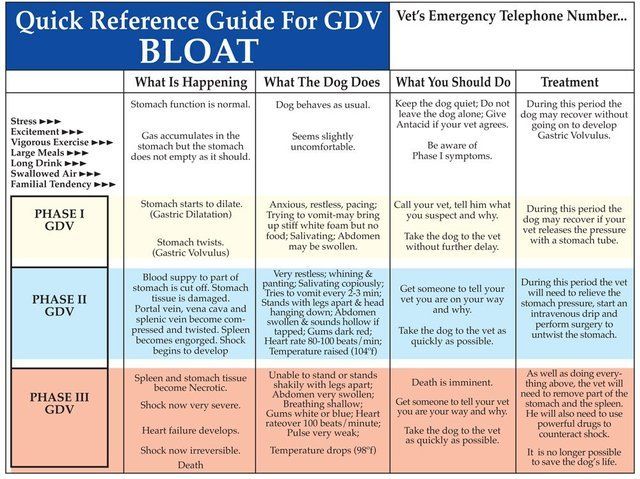Bloat
Everything you need to know
Bloat
What is Bloat?
It is where the stomach fills with gas and fluids and twists on itself. It begins with an abnormal build up of gas in the stomach. Gastric juices are produced and the normal mechanisms for emptying the stomach fail so it begins to swell. The stomach is fixed where the oesophagus enters and once it starts to swell it begins to rotate around this fixed point. This twisting closes the inlet and exit so food or gas cannot escape. Any food present will continue to be digested and ferment thereby increasing the dilation. This cuts off part of the blood supply damaging the tissues of the lining of the stomach. If this is prolonged a portion of the lining may die and the stomach can rupture causing peritonitis. The swelling can trap blood vessels to the liver, spleen and heart and toxic shock will occur. Symptoms may vary and not all dogs will show all symptoms:
Phase 1
- Stomach dilation but not yet twisted.
Anxiety and restlessness, pacing, salivating and whining.
The dog may try to vomit every 10 to 20 mins but brings nothing up or only white frothy saliva.
Anything eaten or drunk will be vomited back in this froth.
There may be an abdominal fullness and the back may be arched.
Phase 2
- Stomach now twisted and shock starting to develop.
Very restless, whining, panting, salivating copiously.
May stand with front legs apart and head down.
Trying to vomit every 2 to 3 mins.
Abdomen enlarged and tight – sounds hollow when tapped.
Gums dark red.
Heart rate 80-100 beats (normal 60-75).
Temperature may be raised.
Phase 3
– Often terminal.
'Shock' well developed and death is imminent.
Gums white or blue.
Breathing shallow.
Unable to stand or very stands shakily with legs spread.
Abdomen very enlarged.
Heart rate over 100 beats per minute.
Temperature drops.
What should you do if you suspect Bloat?
Be alert and know your dog. Call your vet (or the nearest vet if you are not at home) and explain what you suspect or get someone to call and explain you are en route. Take the dog in without delay, TIME IS CRITICAL.
Reducing the risk of Bloat
Feed your dog good quality food.
Do not feed ONE large meal.
Divide the day's ration into two or even three meals and space them well apart. If possible, ensure someone keeps an eye on the dog for at least one hour after a meal.
If you feed a dry food, soak it well beforehand.
If your dog gulps food or eats very quickly, try the following methods of slowing them down: ◦Place two large rubber 'Kongs' (too big to be swallowed) on top of the food in the bowl. The dog will have to push them aside before each mouthful.
Divide the food between the holes of a muffin tin.
Put a pool of yoghurt under the food. Yoghurt fans push the food aside to get at it, taking in small amounts of food along the way.
Feed by hand.
If there is a 'competition' element in the speed two or more dogs eat, try feeding them separately or in separate rooms.
Do not
allow your dog to drink large quantities at one time, especially after a meal.
Avoid
vigorous exercise for one hour before and two hours after a meal.
Avoid
feeding before or during stressful or exciting situations. If appropriate, wait for at least an hour after the stress or excitement has ceased before feeding.
If you change your dog's food, introduce the new one gradually over a 3 to 5 day period.
Teach your dog a command to stop him gobbling up any food you may accidentally drop on the floor.
Avoid
leaving your dog for long periods without checking on him.
If your dog sleeps in an area remote from you, get a baby monitor and position it so you can hear if he becomes distressed during the night.
Study the symptoms of GDV, especially the early ones and be alert for any changes in your dog's behaviour.
Establish a good relationship with your vet and discuss GDV with him.
Bloat Aware

